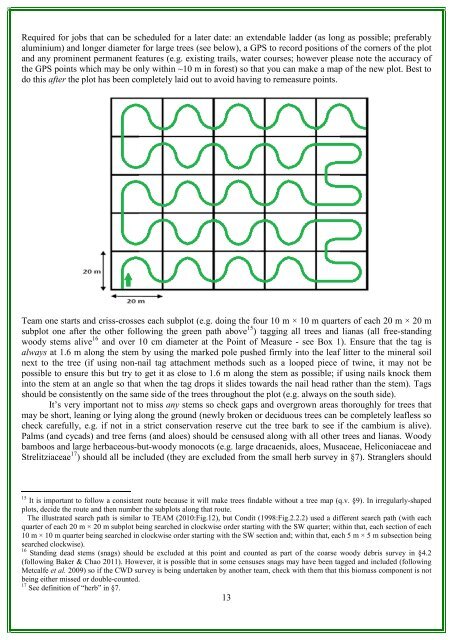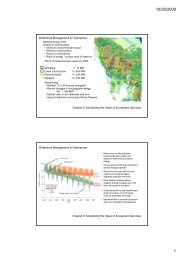RAINFOR GEM Intensive Plots Manual (pdf) - University of Oxford
RAINFOR GEM Intensive Plots Manual (pdf) - University of Oxford
RAINFOR GEM Intensive Plots Manual (pdf) - University of Oxford
- No tags were found...
You also want an ePaper? Increase the reach of your titles
YUMPU automatically turns print PDFs into web optimized ePapers that Google loves.
Required for jobs that can be scheduled for a later date: an extendable ladder (as long as possible; preferablyaluminium) and longer diameter for large trees (see below), a GPS to record positions <strong>of</strong> the corners <strong>of</strong> the plotand any prominent permanent features (e.g. existing trails, water courses; however please note the accuracy <strong>of</strong>the GPS points which may be only within ~10 m in forest) so that you can make a map <strong>of</strong> the new plot. Best todo this after the plot has been completely laid out to avoid having to remeasure points.Team one starts and criss-crosses each subplot (e.g. doing the four 10 m × 10 m quarters <strong>of</strong> each 20 m × 20 msubplot one after the other following the green path above 15 ) tagging all trees and lianas (all free-standingwoody stems alive 16 and over 10 cm diameter at the Point <strong>of</strong> Measure - see Box 1). Ensure that the tag isalways at 1.6 m along the stem by using the marked pole pushed firmly into the leaf litter to the mineral soilnext to the tree (if using non-nail tag attachment methods such as a looped piece <strong>of</strong> twine, it may not bepossible to ensure this but try to get it as close to 1.6 m along the stem as possible; if using nails knock theminto the stem at an angle so that when the tag drops it slides towards the nail head rather than the stem). Tagsshould be consistently on the same side <strong>of</strong> the trees throughout the plot (e.g. always on the south side).It’s very important not to miss any stems so check gaps and overgrown areas thoroughly for trees thatmay be short, leaning or lying along the ground (newly broken or deciduous trees can be completely leafless socheck carefully, e.g. if not in a strict conservation reserve cut the tree bark to see if the cambium is alive).Palms (and cycads) and tree ferns (and aloes) should be censused along with all other trees and lianas. Woodybamboos and large herbaceous-but-woody monocots (e.g. large dracaenids, aloes, Musaceae, Heliconiaceae andStrelitziaceae 17 ) should all be included (they are excluded from the small herb survey in §7). Stranglers should15 It is important to follow a consistent route because it will make trees findable without a tree map (q.v. §9). In irregularly-shapedplots, decide the route and then number the subplots along that route.The illustrated search path is similar to TEAM (2010:Fig.12), but Condit (1998:Fig.2.2.2) used a different search path (with eachquarter <strong>of</strong> each 20 m × 20 m subplot being searched in clockwise order starting with the SW quarter; within that, each section <strong>of</strong> each10 m × 10 m quarter being searched in clockwise order starting with the SW section and; within that, each 5 m × 5 m subsection beingsearched clockwise).16 Standing dead stems (snags) should be excluded at this point and counted as part <strong>of</strong> the coarse woody debris survey in §4.2(following Baker & Chao 2011). However, it is possible that in some censuses snags may have been tagged and included (followingMetcalfe et al. 2009) so if the CWD survey is being undertaken by another team, check with them that this biomass component is notbeing either missed or double-counted.17 See definition <strong>of</strong> “herb” in §7.13





